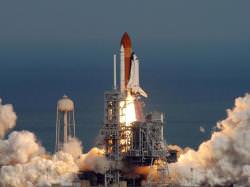Defying a bleak weather forecast, space shuttle Atlantis rocketed into space on Thursday, February 7, on its way to the International Space Station with a new science laboratory. The STS-122 mission had been delayed by a faulty fuel sensor, and was originally scheduled to launch last December. But today there were no problems with the sensor during fueling and the shuttle lifted off flawlessly at 2:45 p.m. EST. On board is a seven member crew and the European Space Agency’s $1.9 billion Columbus science module, Europe’s main contribution to the ISS. Atlantis will rendezvous with the station on Saturday, Feb. 9. The launch came seven years to the day after Atlantis carried NASA’ science laboratory named Destiny to the space station.
“It was a pretty clean launch,” astronaut Jim Dutton radioed the shuttle crew from mission control following the launch. “We did see, at about MET 2:13 (two minutes and 13 seconds after launch) a few piece of debris, they think at least three, that came off inboard of the LO2 (liquid oxygen) feedline just aft of the starboard bipod leg. The debris assessment team indicated they didn’t identify an impact at the time and it’s obviously under evaluation.”
The crew of Atlantis will now check out its systems and inspect the heat shield while chasing down the space station. There will be three spacewalks during the flight so astronauts can attach the Columbus lab and connect its power and fluid lines.
Atlantis’ liftoff came despite concerns that a weather front would interfere with the launch. But the weather cooperated for an on-time launch.
Installing Columbus, named after the 15th-century Italian explorer, is the main task for the 121st space shuttle mission.
“Columbus has discovered a new world, and I think that with Columbus we are discovering a totally new world,” Jean Jacques Dordain, ESA’s director general, said after the launch.
Atlantis’ seven-member crew includes two Europeans, Germany’s Hans Schlegel and France’s Leopold Eyharts. US astronauts are Commander Steven Frick, pilot Alan Poindexter, and mission specialists Leland Melvin, Rex Walheim, and Stanley Love.
“It’s great to have two laboratories in space,” said Bill Gerstenmaier, NASA’s associate administrator for space operations.
The mission is scheduled to last 11 days.
Original News Source: NASA Press Release


Hi,
I have always wondered why it takes the shuttle traveling at about 29,000km/hr to spend three days to catch up with the ISS considering the fact that both are just a few hundred kilometers above us.
Can you please explain to me?
Really glad to see the ISS moving forward,there’s lots of great things in store for us from the space station
Frazier and his Virtual Crew are doing such a great job keeping the rest of us informed in an increasingly busy Space Community, I thought I’d take a quick stab at Akinpelu’s question. He can correct me, or “manner me” as we say in the American South. Actually, it would be very dangerous, but it is within the realm of possibility to launch the Space Shuttle and be within it’s vicinity in a half hour, or less. It’s safe to say that kind of “barnstorming” is strictly out of bounds in the unforgiving environment of Low Earth Orbit. So, again, generally speaking, the Shuttle launches almost precisely into the same orbital plain as the ISS, but initially at a much lower (and therefore, a measurably faster) altitude. While the Earth rotates below, and the ISS orbital plain appears to move westward, the Shuttle uses it’s slightly higher speed, to spend the day and half or more overtaking the ISS, and performing those all-important inspections needed to insure we don’t repeat another Columbia disaster, and also gradually changing the elliptical orbit so the Shuttle finally matches the altitude (and speed) of ISS at the same time the ISS reaches the same point in it’s orbit. That’s about the whole story, but if you ever want to fantasize about what it would be like to rendevous with ISS in 21 minutes, you’ll need to download the free OrbitalSim 2006 P1 program. It’s almost as wonderful a gift to us armchair space explorers as Frazier’s labor or love.
Hello, I would like to know how far you have to travel before you see the circumference of Earth. Thank you very much.
God Bless You All
@Joel: Can you give some more info on that ‘OrbitalSim 2006 P1’ Program? Google for example didn’t come up with anything… Thx
Yes, its great to see the ISS finally moving forward again, and the Europeans must be greatly relieved after their long wait to launch the expensive efforts of their labor. We must not forget that every trip up is taken at great risk. But I think the ground crew is doing a great job of carefully thinking through the risks of every possible issue. They are keeping their thought process very transparent and clear to the public.
Also we should not miss the connection that the Columbia disaster happened only days after the second invasion of Baghdad. This synchronicity should serve to remind us that a great act of reckless hubris can undermine the chances of a great act of fragile, intrepid vulnerability. Acts of violence taken in one area of your life will negatively impact all the other areas of your life, you cannot separate them. This is not a political point, but an energetic one: the effects of our intentions can reach across all material boundaries.